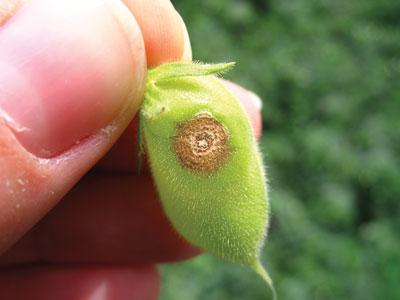
Features
Fungicides
Seed & Chemical
Avoiding ascochyta resistance to fungicides
Chickpea is a lucrative crop in Saskatchewan, but ascochyta infections can decimate a promising yield.
February 24, 2009 By Rosalie I. Tennison
Chickpea is a lucrative crop in Saskatchewan, but ascochyta infections can decimate a promising yield. And now, growers have to be more cautious with fungicide applications, given that some isolates of Ascochyta rabiei have been found to be resistant to some fungicides.
 |
|
| Ascochyta blight symptoms on chickpeas. Photo courtesy of Faye Dokken, Saskatchewan Agriculture and Food. |
According to Faye Dokken, the provincial specialist for plant diseases at Saskatchewan Ministry of Agriculture, isolates of Ascochyta rabiei collected in Alberta and Saskatchewan in 2006 and 2007 were assessed and found to have demonstrated widespread resistance to a strobilurin fungicide. “Loss of effective fungicides due to resistance can be very costly to growers, and proper management is critical to reduce selection pressure,” cautions Dokken.
Research has shown that an early fungicide application can help delay the onset of disease. Subsequently, growers usually make another application to desi varieties (e.g., CDC Cabri), one or two more applications to resistant kabuli varieties (e.g., CDC Frontier), and up to six additional applications to susceptible kabuli varieties (e.g., CDC Xena).
Those types of fungicide application intensities require prudent rotations to prevent fungicide resistance from developing. At greatest risk are the strobilurins, which while very effective, only have a single mode of action.
There were five foliar fungicides registered for control of ascochyta blight on chickpea in 2008: Bravo 500 (Group M), Lance (Group 7), Proline 480 SC (Group 3), and two Group 11 (strobilurin) products, Quadris and Headline Duo. Strobilurins are valuable, effective, broad-spectrum fungicides.
Dokken explains that the risk of developing strobilurin-resistance in chickpea is high because ascochyta is genetically diverse, reproduces sexually with airborne spores, reproduces asexually with multiple short infection cycles during the growing season, and requires several fungicide applications per year, which increases selection pressure for resistant pathogen populations. “Rotate strobilurins with non-strobilurins, or use a registered tank-mix of products from different fungicide groups,” says Dokken. “Remember to check product labels for maximum applications per growing season and for pre-harvest interval timelines.”
What else can be done?
Dokken says currently, there are no varieties of either type of chickpeas that are rated as good for ascochyta tolerance, but pulse breeders at the University of Saskatchewan continue to improve upon the relative resistance of upcoming chickpea varieties. All varieties of desi are rated fair for resistance. But only two varieties of kabuli are similarly rated. The remaining varieties of kabuli are rated as having poor resistance. “Of course we can’t expect to control the environmental conditions that led to ascochyta infections, but there are still many cultural methods growers can use to minimize the risk,” Dokken says. “Crop rotation is one of the best tools for reducing the chances of infection.”
She adds, the longer the rotation the better. The current recommendation is to plant chickpeas one year in four, but Dokken says, if there is a history of severe ascochyta blight, growers should try to stretch the rotation to longer intervals.
Dokken says that if the five foliar fungicides registered for control of ascochyta are used judiciously there is no reason growers need to fear the increase of resistance. Timing of application is critical and she recommends early scouting of the field with the goal to being ready if the fungus is spotted.
In a research project at Swift Current in 2008, ascochyta spores were identified in chickpea residues as early as the week of May 9 to 13. Once observed, the spores remained throughout the spring, which is why Dokken continually advocates regular and rigorous field scouting to ensure ascochyta is spotted at the earliest stages with the possibility of control before environmental conditions cause the infection to spread. “The products need to be applied before the fungus penetrates the plant beginning at about the seven to 10 node stage,” Dokken advises.
Saskatchewan can boast a high number of experienced growers who are doing a great job of management that consistently improves their chances for harvesting a good crop. Dokken suggests growers attempting to grow chickpeas for the first time should start by educating themselves on the best management practices for growing the crop. She strongly advises them to learn to recognize ascochyta infection. Look for the tiny light brown to dark brown spots that can expand into lesions on the lower leaves and start planning a spray strategy. Growers do not want their first hint that ascochyta is present to be the sight of dying plants. “Keeping good field records will also help to minimize resistance, and sharing your management plans with neighbours can help reduce the spread of this disease,” Dokken suggests. “Spores can spread a great distance, so growers want to reduce the chance of spread to neighbouring fields."